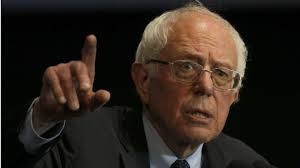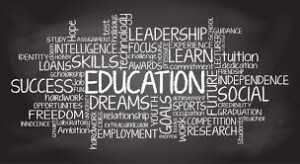 Source: http://www.bbc.com/news/magazine-35364868%5B/caption%5D
Source: http://www.bbc.com/news/magazine-35364868%5B/caption%5D
“Fifty years ago, great schools like the University of California and the City University of New York – as well as many state colleges – were tuition free. Today college is unaffordable for many working class families. For the sake of our economy and millions of Americans, we must make higher education more affordable.” ~Senator Bernie Sanders (I-VT)
For my final civic issues blog, I want to continue my trend of putting an economic spin on education issues by addressing a topic that is very relevant to us, especially this year. This year’s race for President of the United States has seen an interesting race on the Democratic side between former Secretary of State Hillary Clinton and Vermont Senator Bernie Sanders. Senator Sanders’ unique brand of “democratic socialism” has really hit home with the young electorate; in some primary and caucus states, he has commanded 85 percent or more of the under-30 vote. Why is Senator Sanders’ message been so popular? One of the most obvious reasons is his policy on higher education; his plan involves making public education completely tuition-free. Today, I break down Senator Sanders’ education platform and discuss what his opponents have to say about it.
Sen. Sanders splits his platform into six points. In the first he argues that it should not be unreasonable for public higher education to be free. Several of our colleague nations around the world, including Germany, Norway, and Sweden, offer free education. What is the difference here? The economic and government structures of these nations are largely socialist, and the government is much more involved in the economy in the United States. On the other hand, I very much agree with his second point. Over the next ten years, the federal government is projected to make a profit of over $110 billion on student loans. This is particularly alarming in a time when 71 percent, or 1.3 million students are graduating college with debt according to The Institute for College Access & Success. Why is the government trying to profit of a class of students that is supposed to be the future that will support the US economy? Sen. Sanders continues this in point number three, arguing that the government should use this “profit” to nearly halve the student loan interest rate, lowering it to 2.37 percent. The theory stretches to point number four, in which Sen. Sanders would create a program allowing students to refinance existing student loan debt. Step five is more challenging to accomplish: make public colleges cover all financial needs of low-income students, allowing them to repurpose their aid to books, housing, etc. Where is this money going to come from? Sen. Sanders proposes a $75 billion tax package on Wall Street speculators, essentially making them “pay back” the bailouts of 2008.
No wonder Sen. Sanders has been so popular with the young vote! While the plan has reached overwhelming popularity with those that it directly affects, skeptics are not so sure it will work. Let’s first consider the quality point of view. Public schools are in a competitive market for students with their private counterparts. With Sen. Sanders’ plan, students and public schools would be given hefty government subsidies, and private schools would fail to compete and their market share would greatly contract. With no competitive forces, public schools would not see any need to push for innovation and improved service offerings. Now let’s consider the money. The specifics of Sen. Sanders’ Wall Street tax calls for fees of a fraction of a percent in a few different areas. However, the Tax Policy Center estimates that this would only cover $51 billion, causing a shortfall of $24 billion a year. Additionally, the plan asks for the states to foot some of the bill, paying $1 to the federal government’s two. The states in total contributed $73 billion to higher education in 2014 to the students’ $64 billion, a number that will only go up as enrollment numbers continue to increase. States affected by the recent recession already have had to tighten their belts in spending, and having to cover so much of the “College for All” bill would be a struggle. It could come at the cost of cutting funding to other state programs, such as health care, beautiful state parks, and state tourism programs. But it would also most likely come from increases in taxes. Who will pay these tax bills? It might not be us right now, but it will be some day. Either way, we will deal with the expenses of college education. What will work best?
Sources:
https://berniesanders.com/issues/its-time-to-make-college-tuition-free-and-debt-free/
Click to access Debt_Facts_and_Sources.pdf
http://www.usnews.com/opinion/knowledge-bank/2015/05/27/why-bernie-sanders-free-public-college-plan-is-a-bad-idea
http://money.cnn.com/2015/10/16/news/economy/sanders-taxes-spending/
http://www.cnn.com/2016/02/03/politics/bernie-sanders-free-college-costs/

Devastation. This is one word that truly sums up the history of Major League Baseball in the prominent Canadian city of Montreal. The city’s team, the Montreal Expos, experienced many swings in success during their relatively brief existence. Between 1969 and 2004, the Expos won only one National League East division title, in 1981, winning only half of the title since the season was divided by a players’ strike. Attendance also varied greatly over the years, and many wondered whether the city could actually support a franchise. Their best year was in 1994, and excitement was greater than ever, excitement that died when the season was cancelled by yet another players’ strike on August 12, when the Expos held the best record in baseball. Ownership sold the team’s players for scrap, and when new owner Jeffrey Loria spawned new hope, he only let them down. He ultimately sold the team to MLB, and with attendance falling below 5,000 for some games, the Expos were relocated to Washington, DC following the 2004 season. And miraculously, the citizens of Montreal have hope once again.
Despite its tenuous history regarding attendance, Montreal has been a leading name on lists for relocation and expansion of baseball. While there are a few roadblocks, I see several reasons why this is a promising notion. After the team’s departure, the city has been fiercely loyal to the Expos’ brand. Many citizens still purchase Expos’ merchandise in stores. Others, namely Montreal Mayor Denis Coderre, have been very supportive of bringing a team back to the city. A $400,000 study commissioned to study Montreal’s viability as an option for baseball offered a very promising outlook. The people of Montreal as a whole have made statements to this effect as well. Over the past several years, the Toronto Blue Jays, now Canada’s sole MLB team, have played two two-game exhibition series in Olympic Stadium, the Expos’ old home. Each series drew over 96,000 fans over the two-day span, crushing the dismal numbers posted in the Expos’ final year in Montreal. What does this mean? Montreal is more serious now about baseball than it was when the Expos were still in town.
What are the obstacles? The most drastic issue is that of the stadium. Built as the centerpiece for the 1976 Summer Olympics, Montreal’s Olympic Stadium has been a nightmare from the beginning. To start, construction delays stemming from financing problems and the stadium’s bizarre design resulted in the stadium not even being finished before the start of the 1976 Games. The roof was quite an issue as well; initially meant to be retractable, the retracting function failed immediately, and it had to be replaced with a permanent roof, which itself has collapsed several times. The stadium’s costs were not fully paid off until 2006, the second season played after the Expos were shipped off to Washington. Needless to say, the stadium is a problem. Commissioner Rob Manfred has more or less mandated that Montreal build a new stadium if it wants a team back, which will cost hundreds of millions of dollars. Nonetheless, people are supportive, and several sites exist, including one right on the water. Of all places to get a team, I would most like to see Montreal get the Expos back. A city yearning for baseball, especially one that has endured so much heartbreak, is definitely a worthy location.
My prediction: 85 percent chance Montreal receives a team in the next twenty years.
Source: http://www.nytimes.com/2015/08/19/sports/baseball/baseball-fever-remains-in-montreal-with-hope-of-a-new-team.html?_r=0
 While the design is striking, Olympic Stadium has provided nothing but problems for Montreal.
While the design is striking, Olympic Stadium has provided nothing but problems for Montreal.
Source: http://www.theguardian.com/sport/2014/mar/30/major-league-baseball-brief-return-montreal-runaway-success%5B/caption%5D
 Over 46,000 fans flocked to Olympic Stadium to see the Blue Jays play the Reds in a preseason matchup last year.
Over 46,000 fans flocked to Olympic Stadium to see the Blue Jays play the Reds in a preseason matchup last year.
Source: http://www.foxsports.com/mlb/story/fans-pack-montreal-stadium-to-watch-cincinnati-reds-top-toronto-blue-jays-040315%5B/caption%5D
So far in this blog series, I have focused largely on education policy from a broad, economic standpoint. In our nation, we have resources that are both public and private; those provided by the government and those provided through the open market. In each of these breakdowns, I have been reinforcing the conclusion that while it is not a bad thing to have public education, it is fundamentally flawed. Despite spending the fifth-most on public education globally, we rank only seventeenth among developed countries according to the Organization for Economic Cooperation and Development (OECD). Therefore, even though we make a large public investment in education through our tax dollars, it is producing less than optimal results. This week, I will break down an article written by Dr. David E. Drew of the School of Educational Studies at the Claremont Graduate University. In this piece, Dr. Drew analyzes the three main “mistakes” made in the American system of public education that has led to its relative weakness in comparison to other world powers. The first revolves around the term aptitude.
Aptitude: You Know What They Say About Assuming…
One of America’s main problems with education is assumption made based on aptitude. When a student struggles with a subject such as math, they are made to believe that they simply do not have enough intelligence to learn it. If students are rated based on aptitude, a correlation between aptitude and socio-economic background often develops. Students that struggle with math are usually brushed off and given less challenging courses, thus performing at lower level and lowering the overall performance of a public school. Only a small amount of students will actually be subjected to higher-level mathematics instruction because their aptitude shows that they can handle it. Students that are proficient in mathematics and thus are taught higher level courses often come from affluent families. Since they are set up to succeed in more challenging subjects, they are set up to succeed in life. The affluent children become the affluent adults, and the economic cycle renews. In China, students are never told that they are not smart enough to tackle subject matter. Since instructors assume that topics can be mastered with hard work, nearly all Chinese students receive high-level mathematics instruction. How can this be stopped? Teaching methods must be updated, a topic I addressed in my TED Talk. By fostering collaborative learning through innovative and supportive teaching, educators can help students achieve at a level beyond their “aptitude.”
Politics: Big Words Aren’t Helping, But Neither is Fast Talk
What I am sharing next from Dr. Drew’s article probably is not a big surprise. There is a big disconnect between elected officials and those they represent. I know, you can sit back down know. Even more exciting, mistake number two relates to rhetoric! Educational researchers have a penchant for using excessive jargon that is not truly readable to the general public, but especially politicians. Though lawmakers understand the need for fundamental education reform, they can draw next to no ideas from educated reports they can’t comprehend. From the other perspective, educators think that politicians have no understanding of the depth and complexity of the issues in public education. This is also true. Politicians are self-involved to the point that they don’t like to look beyond the surface. Thus, the perfect storm is created. Politicians don’t understand the issue, likely because those who are authorities on the subject have overcomplicated it. The solution: politicians fully read and comprehend ideas proposed in a simplified manner by educators. Learning from past successes and failures is key.
Standardized Testing: Beat the Test Instead of Teaching to It
I will keep my summary for this section brief as I know several other education blog writers are passionate about standardized testing and have written very detailed posts on the subject. Here are the three main points. First, standardized testing takes too many days and hours away from instructional time. Second, multiple-choice testing does not fully reflect the ability of students. Third, a cross-section of part of the educational process such as testing is not a fair barometer of who a student is and why they may struggle in certain areas. How could we balance this? Dr. Drew suggests that the teacher balances the weight of standardized testing results with a qualitative analysis of the student.
This is just a small sample of the many issues being considered regarding the future of public education. While public education is far from dead, fundamental reform is necessary to reconcile education spending with education performance.
Source: http://www.cgu.edu/include/ClaremontLetteri2v1.pdf
 Source: http://www.bcrwealth.com/category/education-children%5B/caption%5D
Source: http://www.bcrwealth.com/category/education-children%5B/caption%5D
 Source: http://www.bbc.com/news/magazine-35364868%5B/caption%5D
Source: http://www.bbc.com/news/magazine-35364868%5B/caption%5D

 While the design is striking, Olympic Stadium has provided nothing but problems for Montreal.
While the design is striking, Olympic Stadium has provided nothing but problems for Montreal. Over 46,000 fans flocked to Olympic Stadium to see the Blue Jays play the Reds in a preseason matchup last year.
Over 46,000 fans flocked to Olympic Stadium to see the Blue Jays play the Reds in a preseason matchup last year. Source: http://www.bcrwealth.com/category/education-children%5B/caption%5D
Source: http://www.bcrwealth.com/category/education-children%5B/caption%5D